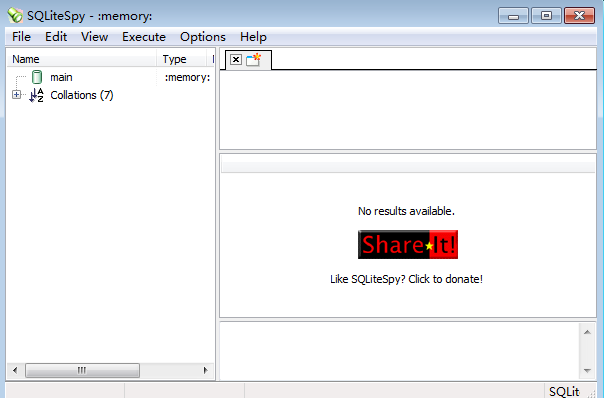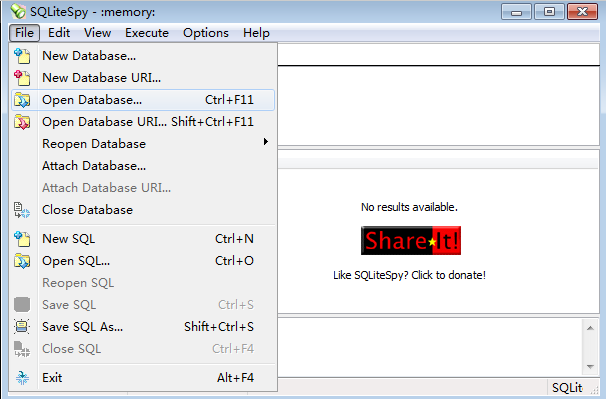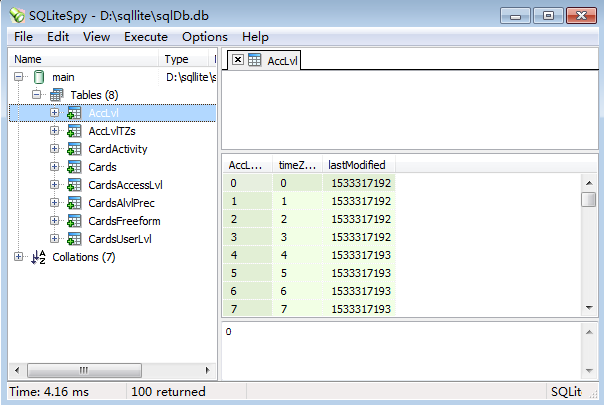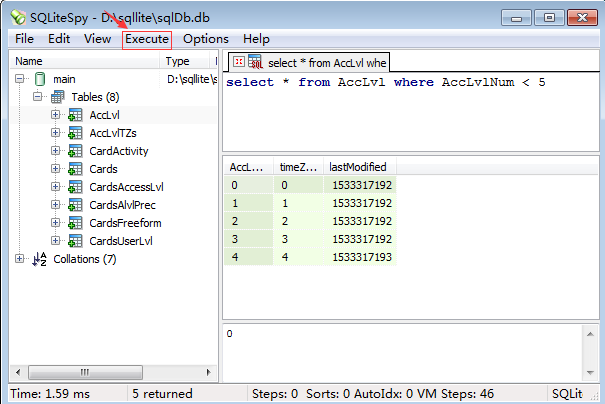SQLite是一个很轻量的数据库。详细介绍我就不多说了,这个东西应该在嵌入式里面用得比较多。根据我看到的资料(几个月以前看的),现在安卓应用应该也会用这个,HTML5 也支持sqlite。
SQLite也支持 SQL 语句。它的每一个数据库都是一个后缀为db的文件
我手里有一个这样的文件,里面已经有一些数据了。

怎么访问这个数据?
1. 最简单的在 windows 平台下下载一个 SQLiteSpy 程序

a. File->Open Database, 选择要打开的 .db 文件

可以看到

执行一条简单的sql

2. 使用 Java JDBC 访问 SQLite 数据库
需要添加驱动依赖
<!-- https://mvnrepository.com/artifact/org.xerial/sqlite-jdbc --> <dependency> <groupId>org.xerial</groupId> <artifactId>sqlite-jdbc</artifactId> <version>3.23.1</version> </dependency>
java代码
import java.sql.Connection; import java.sql.DriverManager; import java.sql.PreparedStatement; import java.sql.ResultSet; import java.sql.SQLException; public class App { public static void main(String[] args) { String url = "jdbc:sqlite:sqlDb.db"; Connection conn = null; PreparedStatement pStatement = null; ResultSet resultSet = null; try { Class.forName("org.sqlite.JDBC"); conn = DriverManager.getConnection(url); pStatement = conn.prepareStatement("select * from `AccLvl`"); resultSet = pStatement.executeQuery(); while(resultSet.next()) { System.out.println("AccLvlNum:" + resultSet.getInt("AccLvlNum") + " " + "timeZoneTableId: " + resultSet.getInt("timeZoneTableId") + " " + "lastModified: " + resultSet.getTimestamp("lastModified")); } } catch (ClassNotFoundException e) { // TODO Auto-generated catch block e.printStackTrace(); } catch (SQLException e) { // TODO Auto-generated catch block e.printStackTrace(); }finally { try { if(resultSet != null) { resultSet.close(); } if(pStatement != null) { pStatement.close(); } if(conn != null) { conn.close(); } } catch (SQLException e) { e.printStackTrace(); } } } }
程序执行结果
AccLvlNum:0 timeZoneTableId: 0 lastModified: 1970-01-19 01:55:17.192 AccLvlNum:1 timeZoneTableId: 1 lastModified: 1970-01-19 01:55:17.192 AccLvlNum:2 timeZoneTableId: 2 lastModified: 1970-01-19 01:55:17.192 AccLvlNum:3 timeZoneTableId: 3 lastModified: 1970-01-19 01:55:17.192 AccLvlNum:4 timeZoneTableId: 4 lastModified: 1970-01-19 01:55:17.193 AccLvlNum:5 timeZoneTableId: 5 lastModified: 1970-01-19 01:55:17.193 AccLvlNum:6 timeZoneTableId: 6 lastModified: 1970-01-19 01:55:17.193 AccLvlNum:7 timeZoneTableId: 7 lastModified: 1970-01-19 01:55:17.193 AccLvlNum:8 timeZoneTableId: 8 lastModified: 1970-01-19 01:55:17.193 AccLvlNum:9 timeZoneTableId: 9 lastModified: 1970-01-19 01:55:17.194 AccLvlNum:10 timeZoneTableId: 10 lastModified: 1970-01-19 01:55:17.194 AccLvlNum:11 timeZoneTableId: 11 lastModified: 1970-01-19 01:55:17.194 AccLvlNum:12 timeZoneTableId: 12 lastModified: 1970-01-19 01:55:17.194 AccLvlNum:13 timeZoneTableId: 13 lastModified: 1970-01-19 01:55:17.194 AccLvlNum:14 timeZoneTableId: 14 lastModified: 1970-01-19 01:55:17.194 AccLvlNum:15 timeZoneTableId: 15 lastModified: 1970-01-19 01:55:17.195 AccLvlNum:16 timeZoneTableId: 16 lastModified: 1970-01-19 01:55:17.195 AccLvlNum:17 timeZoneTableId: 17 lastModified: 1970-01-19 01:55:17.195
3. linux 访问(Ubuntu)
首先安装 sqlite3
sudo apt-get install sqlite3
然后创建一个数据库,之前说了sqlite 的数据库就是一个 db 文件。 然后就可以进行数据库操作了,大体语法跟mysql是一样的,有细微的区别
vmware@ubuntu:~/frank$ sqlite3 test.db SQLite version 3.11.0 2016-02-15 17:29:24 Enter ".help" for usage hints. sqlite> .table sqlite> create table t_user( ...> id integer primary key autoincrement, ...> name varchar(20) not null, ...> password varchar(20) not null ...> ); sqlite> insert into t_user(name, password) values ('jordan','1234'),('kobe', '3456'),('james', '7890'); sqlite> select * from t_user; 1|jordan|1234 2|kobe|3456 3|james|7890 sqlite> select * from t_user where name='kobe'; 2|kobe|3456 sqlite>
用到的sql
.table create table t_user( id integer primary key autoincrement, name varchar(20) not null, password varchar(20) not null ); insert into t_user(name, password) values ('jordan','1234'),('kobe', '3456'),('james', '7890'); select * from t_user select * from t_user where name='kobe';